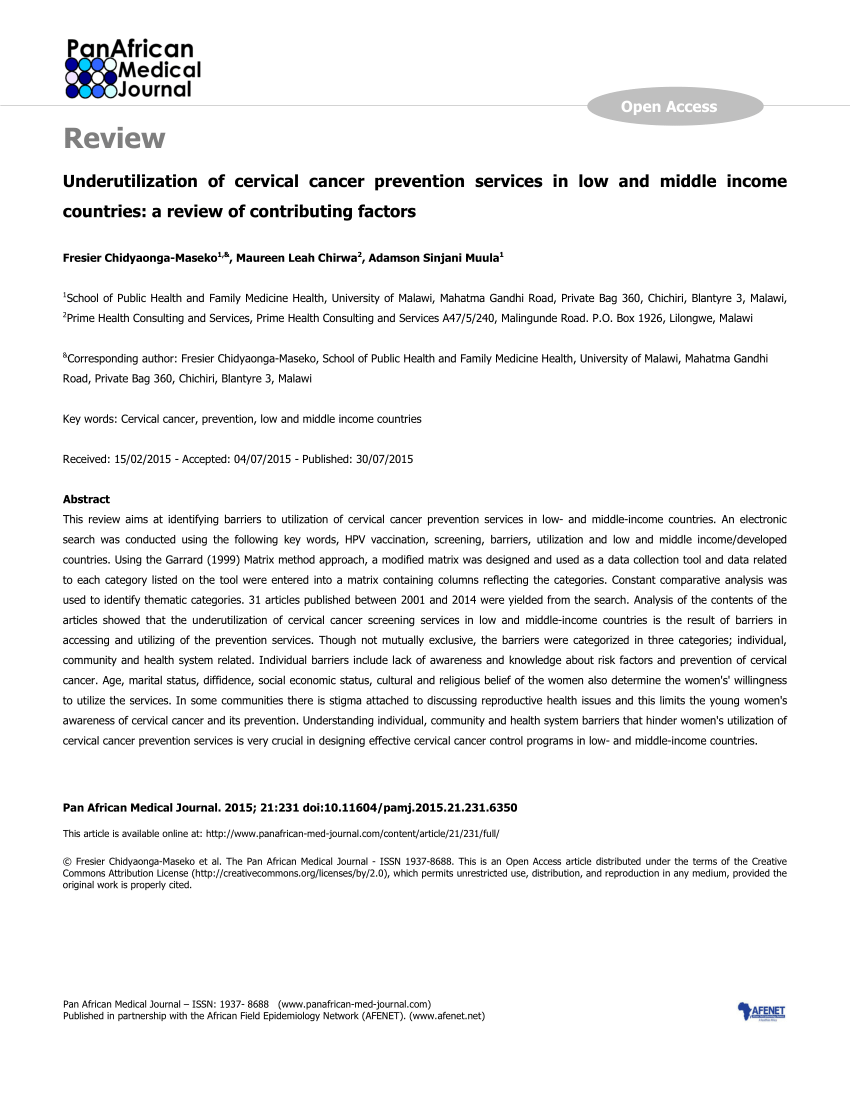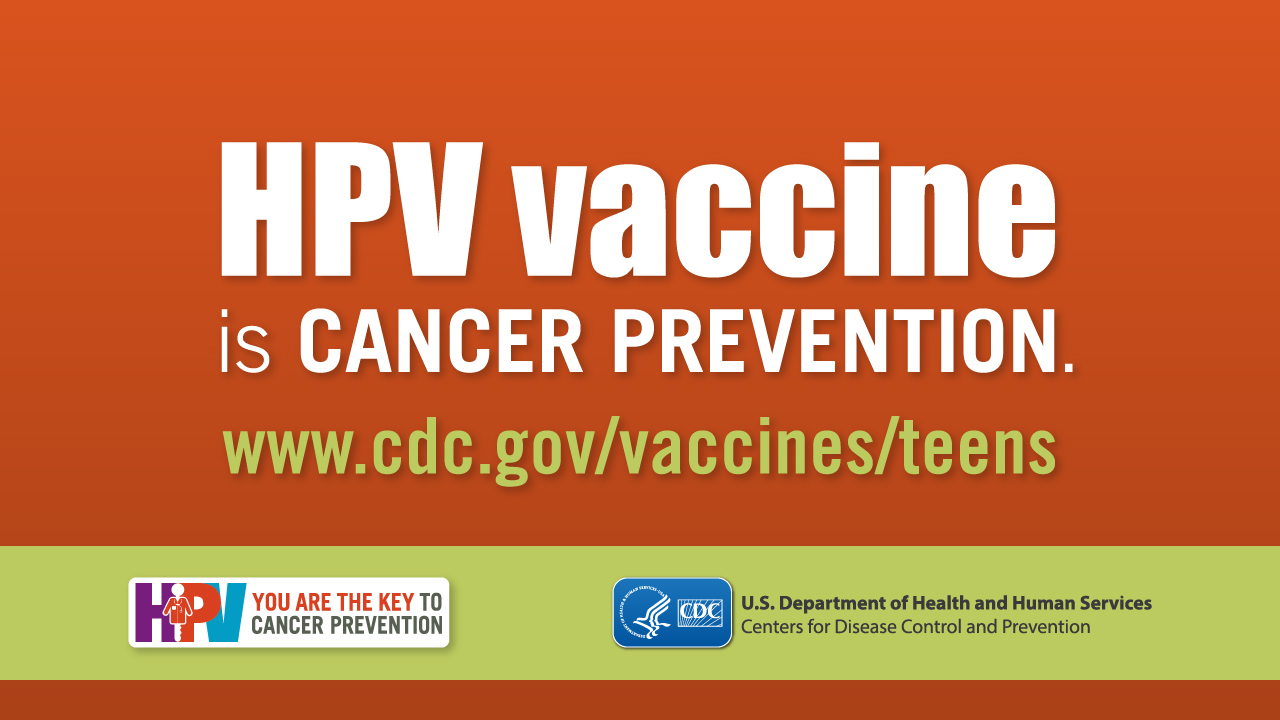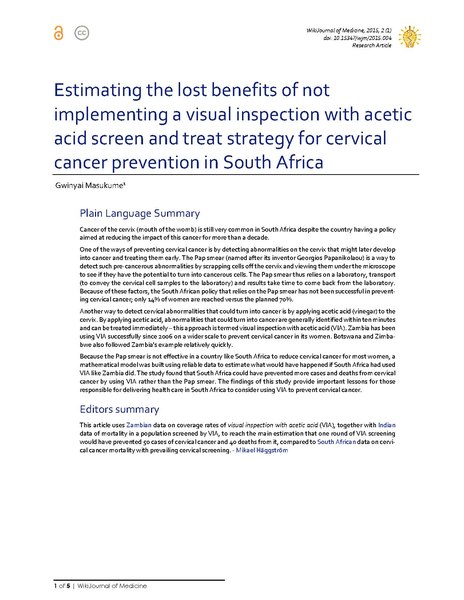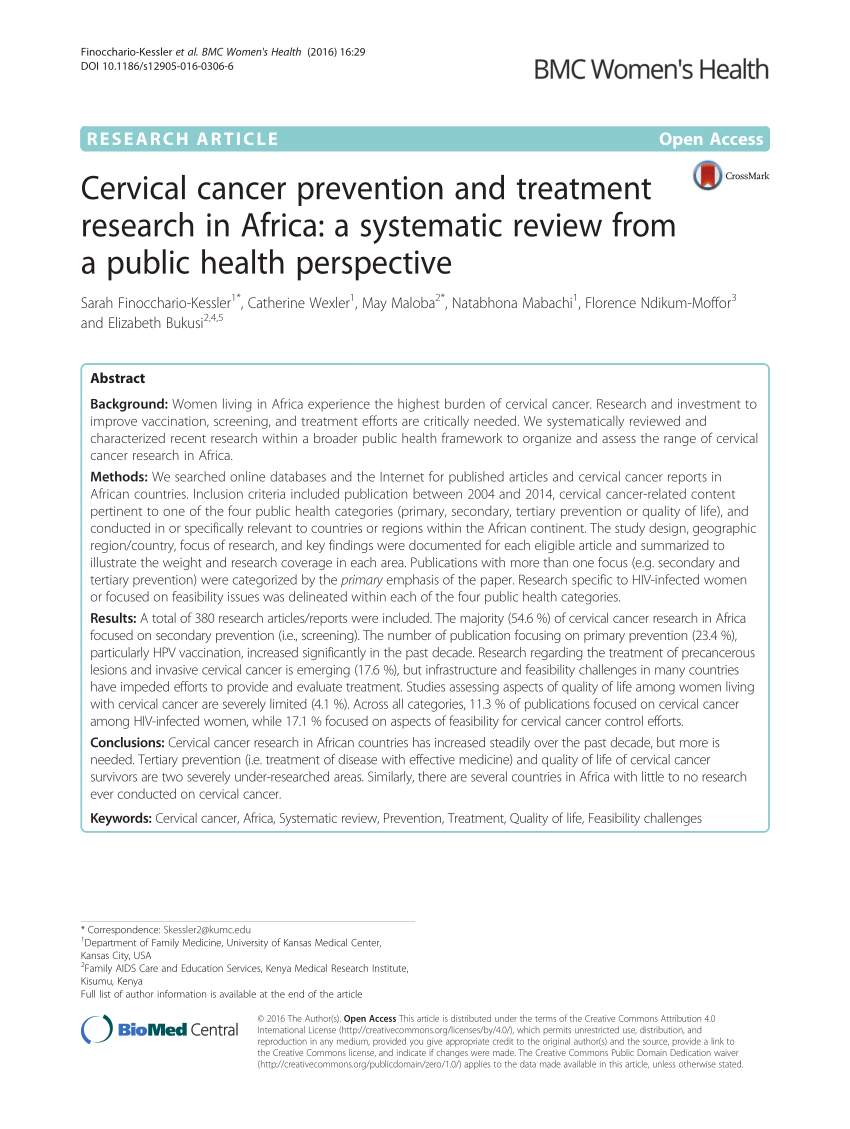
Accelerating cervical cancer control and prevention The SECONDARY PREVENTION: CERVICAL CANCER SCREENING. Since the introduction of the Papanicolaou (Pap) test, US cervical cancer incidence rates have decreased by more than 60%. 16 Because almost all cervical cancer is preventable with proper screening, all women ages 21 to 65 should be screened.
Cervical cancer prevention and screening the role of
Cervical cancer The Lancet. Oct 10, 2014 · Cervical cancer is the third most common cause of cancer in women in the world. During the past few decades tremendous strides have been made toward decreasing the incidence and mortality of cervical cancer with the implementation of various …, Jul 01, 2019 · In a 2016 study, Tosteson et al 10 showed that in a range of primary care practices, only 46% of abnormal cervical cancer screening test results were appropriately triaged for evaluation. The effectiveness of all cervical cancer screening is directly linked to timely evaluation of patients with abnormal results..
Construct a cancer prevention plan for a patient at risk of breast, colorectal, human papillomavirus–related, or prostate cancer. 4.Distinguish between cancer screening guideline recommendations for breast, cervical, colorectal, lung, and prostate About this chapter. This chapter of the National Cancer Prevention Policy combines information about human papillomavirus immunisation and cervical screening, which were two separate chapters in previous editions of the NCPP.. The chapter was updated in August 2018 following the implementation of the renewed National Cervical Screening Program.
Cervical cancer prevention is possible by using Pap tests, tests to detect human papillomavirus (HPV), and HPV vaccination. Learn more about how to prevent cervical cancer in this expert-reviewed summary. Cervical Cancer Screening and Prevention Management of Abnormal Results Kathy A. King, MD Assistant Professor of OB/GYN Medical Director, PPWI Medical College of Wisconsin May 6, 2016. Objectives •Overview of cervical cancer and oncogenic HPV •Review of cervical cancer prevention and
Cervical Cancer Screening and Prevention Management of Abnormal Results Kathy A. King, MD Assistant Professor of OB/GYN Medical Director, PPWI Medical College of Wisconsin May 6, 2016. Objectives •Overview of cervical cancer and oncogenic HPV •Review of cervical cancer prevention and or cervical cancer, or a precancerous condition of the breast or cervix. & Cervical Breast Cancer PREVENTION AND TREATMENT PROGRAM (BCCPT) Important health care coverage information for women with breast or cervical cancer, or a precancerous condition of the breast or cervix. If you need translation services free of charge, please call 1-800
UN Joint Global Programme on Cervical Cancer Prevention and Control Worldwide, 266,000 women died of cervical cancer in 2012– equivalent of one women dying every 2 minutes. And 90% of these deaths were in low- and middle-income countries. But the truth is that almost all of these deaths could be avoided if all adolescent girls were immunized Cervical cancer prevention stems from the knowledge that certain types of human papillomavirus (HPV) are responsible for nearly all cervical cancers. Get detailed information about the factors associated with cervical cancer risk and approaches for preventing it in this summary for clinicians.
Cervical Cancer Screening and Prevention •In women ≥ 25 the FDA approved primary HPV screening test can be considered an alternative to current cytology based screening. Cytology alone and co‐testing remain the options specifically recommended in current major society guidelines. If used, UN Joint Global Programme on Cervical Cancer Prevention and Control Worldwide, 266,000 women died of cervical cancer in 2012– equivalent of one women dying every 2 minutes. And 90% of these deaths were in low- and middle-income countries. But the truth is that almost all of these deaths could be avoided if all adolescent girls were immunized
Cervical Cancer Screening and Prevention •In women ≥ 25 the FDA approved primary HPV screening test can be considered an alternative to current cytology based screening. Cytology alone and co‐testing remain the options specifically recommended in current major society guidelines. If used, As a result, cervical cancer has now become a sentinel disease of inequality, being much more common in poor countries and in aboriginal populations in Western countries 6, 7. In 2008, more than 85% of cases and of deaths attributed to cervical cancer (530,000 and 270,000 respectively) occurred in …
prevention of cervical cancer and the aim of the literature review is to promote high quality care and health care education. The study question is: What are the best practices of cervical cancer prevention? Best practice refers to commercial or professional procedures which are accepted or Jan 06, 2019 · Comprehensive Cervical cancer prevention and control programme guidance for countries This guidance has been developed for UNFPA country offices and programme managers in the Ministry of Health who would wish to develop or update cervical cancer prevention and control programmes.
Cervical Cancer Screening and Prevention •In women ≥ 25 the FDA approved primary HPV screening test can be considered an alternative to current cytology based screening. Cytology alone and co‐testing remain the options specifically recommended in current major society guidelines. If used, ments in cervical cancer prevention. Vaccination generates HPV specific antibodies that bind to the virus and pre-vent cervical infection. There are three types of HPV vaccines currently in use. CervarixR is a bivalent vaccine that protects against HPV types 16 and 18 (associated with cervical can-cer).
Cervical cancer is one of the few cancers that’s almost totally preventable. It comes down to avoiding human papillomavirus, or HPV, which is sexually transmitted. HPV is the top cause of Finally, the association between human papilloma virus (HPV) infection and cervical cancer makes HPV vaccination a crucial step in cervical cancer prevention. Continued provider education regarding HPV vaccination can improve knowledge about the HPV vaccine, 8 as well as improve vaccination rates.
Oct 10, 2014 · Cervical cancer is the third most common cause of cancer in women in the world. During the past few decades tremendous strides have been made toward decreasing the incidence and mortality of cervical cancer with the implementation of various … The Pima County Cervical Cancer Prevention Partnership (PCCCPP) funded by the CDC under the REACH U.S. initiative attempts to foster a sustainable systemic response to cervical cancer prevention. PCCCPP, which includes school districts, community health centers, county government and community-based organizations, has grown out of a community
WHO Prevention and control of cervical cancer

How Do I Prevent Cervical Cancer? 4 Ways to Prevent. Cervical cancer is the fourth most common cancer in women, and the seventh overall, with an estimated 528,000 new cases and 266,000 deaths in 2012 [1]. Almost nine out of ten (87%) cervical cancer deaths occur in the less-developed regions of the world. The cervical cancer incidence significantly, Jan 12, 2019 · Cervical cancer is the fourth most common cancer affecting women worldwide and the second commonest cancer affecting women in developing countries. In 2012 there were 530,000 new diagnoses (7.5% of all new cancer diagnoses in women) with 84% of these in resource-poor countries..
Secondary prevention of cervical cancer

Screening for Cervical Cancer Putting Prevention into. What is cervical cancer? Cervical cancer is a cancer that forms in the tissues of the cervix. It is usually a slow-growing cancer that may not have symptoms but can be detected through screening tests. Cervical cancer is almost always caused by HPV infection, with HPV … https://ro.wikipedia.org/wiki/Cancer_cervical Cervical cancer is one of the few cancers that’s almost totally preventable. It comes down to avoiding human papillomavirus, or HPV, which is sexually transmitted. HPV is the top cause of.

Sep 01, 2012 · The Asia Oceania region contributes to more than 50% of cervical cancer cases worldwide. Yet cervical cancer is one of few cancers that can be prevented through comprehensive screening for precancerous lesions, with their subsequent treatment. Screening with cervical cytology, a very old technology, has reduced cervical cancer mortality and incidence when applied in … As a result, cervical cancer has now become a sentinel disease of inequality, being much more common in poor countries and in aboriginal populations in Western countries 6, 7. In 2008, more than 85% of cases and of deaths attributed to cervical cancer (530,000 and 270,000 respectively) occurred in …
or cervical cancer, or a precancerous condition of the breast or cervix. & Cervical Breast Cancer PREVENTION AND TREATMENT PROGRAM (BCCPT) Important health care coverage information for women with breast or cervical cancer, or a precancerous condition of the breast or cervix. If you need translation services free of charge, please call 1-800 Cervical cancer is the fourth most common cancer in women, and the seventh overall, with an estimated 528,000 new cases and 266,000 deaths in 2012 [1]. Almost nine out of ten (87%) cervical cancer deaths occur in the less-developed regions of the world. The cervical cancer incidence significantly
Cervical cancer prevention and screening: the role of human papillomavirus testing Mehrnoosh Aref-Adib MBBS MA MRCOG,a Theresa Freeman-Wang MBChB MRCOG b,* aST6 Specialty Trainee in Obstetrics and Gynaecology, Whipps Cross University Hospital, Whipps Cross Road, London E11 1NR, UK bConsultant Gynaecologist, Whittington Hospital, Department of Women’s Health, Jenner Building, Magdala Avenue prevention of cervical cancer and the aim of the literature review is to promote high quality care and health care education. The study question is: What are the best practices of cervical cancer prevention? Best practice refers to commercial or professional procedures which are accepted or
Cervical cancer is usually caused by alterations in the cervix that take place slowly over time. Human papillomavirus (HPV), a sexually transmitted infection, is the leading risk factor. Lifestyle approaches and vaccination may help prevent you from getting HPV infection. cervical cancer prevention and control programme.. 217 Practice Sheet 2.2: Key performance and impact indicators for national cervical cancer prevention and control programmes..... 218 Practice Sheet 3.1: Key messages for cervical cancer outreach and education .. 222
Construct a cancer prevention plan for a patient at risk of breast, colorectal, human papillomavirus–related, or prostate cancer. 4.Distinguish between cancer screening guideline recommendations for breast, cervical, colorectal, lung, and prostate Cervical cancer prevention is possible by using Pap tests, tests to detect human papillomavirus (HPV), and HPV vaccination. Learn more about how to prevent cervical cancer in this expert-reviewed summary.
Cervical Cancer Screening and Prevention •In women ≥ 25 the FDA approved primary HPV screening test can be considered an alternative to current cytology based screening. Cytology alone and co‐testing remain the options specifically recommended in current major society guidelines. If used, Cervical Cancer Screening and Prevention •In women ≥ 25 the FDA approved primary HPV screening test can be considered an alternative to current cytology based screening. Cytology alone and co‐testing remain the options specifically recommended in current major society guidelines. If used,
Cervical cancer prevention stems from the knowledge that certain types of human papillomavirus (HPV) are responsible for nearly all cervical cancers. Get detailed information about the factors associated with cervical cancer risk and approaches for preventing it in this summary for clinicians. As a result, cervical cancer has now become a sentinel disease of inequality, being much more common in poor countries and in aboriginal populations in Western countries 6, 7. In 2008, more than 85% of cases and of deaths attributed to cervical cancer (530,000 and 270,000 respectively) occurred in …
Cervical Cancer Prevention and Early Detection. Get information on cervical cancer, including the causes and risk factors. Learn about the tests that can help detect it … About this chapter. This chapter of the National Cancer Prevention Policy combines information about human papillomavirus immunisation and cervical screening, which were two separate chapters in previous editions of the NCPP.. The chapter was updated in August 2018 following the implementation of the renewed National Cervical Screening Program.
What is cervical cancer? Cervical cancer is a cancer that forms in the tissues of the cervix. It is usually a slow-growing cancer that may not have symptoms but can be detected through screening tests. Cervical cancer is almost always caused by HPV infection, with HPV … "Each year, approximately 12,000 women in the United States get cervical cancer. Although all women are at risk for cervical cancer, all women do not have to get this cancer. Cervical cancer can be prevented or treated, if found early. The keys to prevention and control are Education, Vaccination, and Screening are keys to prevention and control."
Jan 25, 2019 · The January session of Grand Rounds “Preventing Cervical Cancer in the 21st Century,” was viewed in 7 foreign countries and in 47 states, plus the District of Columbia. Each year more than 4,000 U.S. women die from cervical cancer, the 4 th most … About this chapter. This chapter of the National Cancer Prevention Policy combines information about human papillomavirus immunisation and cervical screening, which were two separate chapters in previous editions of the NCPP.. The chapter was updated in August 2018 following the implementation of the renewed National Cervical Screening Program.
or cervical cancer, or a precancerous condition of the breast or cervix. & Cervical Breast Cancer PREVENTION AND TREATMENT PROGRAM (BCCPT) Important health care coverage information for women with breast or cervical cancer, or a precancerous condition of the breast or cervix. If you need translation services free of charge, please call 1-800 (cervical cancer vaccination) before having sexual experience Avoid smoking Apart from the measures highlighted above, cervical cancer screening offers you additional protection. Regular cervical cancer screening by cervical smear (also named Pap smear) and timely treatment of the detected pre-cancerous changes can effectively prevent cervical
Cervical cancer screening and treatment in Uganda

Cervical Cancer Prevention and Early Detection. Cervical cancer occurs when abnormal cells on the cervix grow out of control. The cervix is the lower part of the uterus that opens into thevagina. Cervical cancer can often be successfully treated when it's found early. It is usually found at a very early stage through a Pap test. Cervical cancer is one of the most common cancers in women, Jan 12, 2019 · Cervical cancer is the fourth most common cancer affecting women worldwide and the second commonest cancer affecting women in developing countries. In 2012 there were 530,000 new diagnoses (7.5% of all new cancer diagnoses in women) with 84% of these in resource-poor countries..
The road ahead for cervical cancer prevention and control
(PDF) Cervical cancer prevention and treatment research in. CERVICAL CANCER 500,000+ new cases and 275,000 attributable deaths world-wide in 2008 11,000+ new cases and 4,000 attributable deaths in 2011 in the U.S. 37% cervical cancers occur in women who are between the ages of 20 and 44 13% (or nearly 1 in 8) between 20 and 34 24% ( or nearly 1 in 4) between 35 and 44 CDC., Cervical cancer prevention stems from the knowledge that certain types of human papillomavirus (HPV) are responsible for nearly all cervical cancers. Get detailed information about the factors associated with cervical cancer risk and approaches for preventing it in this summary for clinicians..
Jul 15, 2019 · Breast and colorectal cancer screenings are the other two. According to the Centers for Disease Control and Prevention, routine cervical cancer screening is an effective way to reduce the burden of cervical cancer by finding the cancer early, when it is easier to treat. The screening can also detect precancerous changes to cervical tissue Jan 01, 2018 · Cervical cancer is probably the best understood and most preventable of all major human malignancies. The progressive steps of this disease—human papillomavirus (HPV) infection, progression to precancer, and invasion—are well described (figure).1 Sexual transmission of causal HPV infections is ubiquitous but the rates of cervical cancer vary widely, inversely related to the effectiveness
Jul 15, 2019 · Breast and colorectal cancer screenings are the other two. According to the Centers for Disease Control and Prevention, routine cervical cancer screening is an effective way to reduce the burden of cervical cancer by finding the cancer early, when it is easier to treat. The screening can also detect precancerous changes to cervical tissue CERVICAL CANCER 500,000+ new cases and 275,000 attributable deaths world-wide in 2008 11,000+ new cases and 4,000 attributable deaths in 2011 in the U.S. 37% cervical cancers occur in women who are between the ages of 20 and 44 13% (or nearly 1 in 8) between 20 and 34 24% ( or nearly 1 in 4) between 35 and 44 CDC.
Cervical cancer is one of the few cancers that’s almost totally preventable. It comes down to avoiding human papillomavirus, or HPV, which is sexually transmitted. HPV is the top cause of prevention of cervical cancer and the aim of the literature review is to promote high quality care and health care education. The study question is: What are the best practices of cervical cancer prevention? Best practice refers to commercial or professional procedures which are accepted or
ments in cervical cancer prevention. Vaccination generates HPV specific antibodies that bind to the virus and pre-vent cervical infection. There are three types of HPV vaccines currently in use. CervarixR is a bivalent vaccine that protects against HPV types 16 and 18 (associated with cervical can-cer). "Each year, approximately 12,000 women in the United States get cervical cancer. Although all women are at risk for cervical cancer, all women do not have to get this cancer. Cervical cancer can be prevented or treated, if found early. The keys to prevention and control are Education, Vaccination, and Screening are keys to prevention and control."
(cervical cancer vaccination) before having sexual experience Avoid smoking Apart from the measures highlighted above, cervical cancer screening offers you additional protection. Regular cervical cancer screening by cervical smear (also named Pap smear) and timely treatment of the detected pre-cancerous changes can effectively prevent cervical Sep 01, 2012 · The Asia Oceania region contributes to more than 50% of cervical cancer cases worldwide. Yet cervical cancer is one of few cancers that can be prevented through comprehensive screening for precancerous lesions, with their subsequent treatment. Screening with cervical cytology, a very old technology, has reduced cervical cancer mortality and incidence when applied in …
Cervical cancer prevention stems from the knowledge that certain types of human papillomavirus (HPV) are responsible for nearly all cervical cancers. Get detailed information about the factors associated with cervical cancer risk and approaches for preventing it in this summary for clinicians. Jan 06, 2019 · Comprehensive Cervical cancer prevention and control programme guidance for countries This guidance has been developed for UNFPA country offices and programme managers in the Ministry of Health who would wish to develop or update cervical cancer prevention and control programmes.
UN Joint Global Programme on Cervical Cancer Prevention and Control Worldwide, 266,000 women died of cervical cancer in 2012– equivalent of one women dying every 2 minutes. And 90% of these deaths were in low- and middle-income countries. But the truth is that almost all of these deaths could be avoided if all adolescent girls were immunized (cervical cancer vaccination) before having sexual experience Avoid smoking Apart from the measures highlighted above, cervical cancer screening offers you additional protection. Regular cervical cancer screening by cervical smear (also named Pap smear) and timely treatment of the detected pre-cancerous changes can effectively prevent cervical
Construct a cancer prevention plan for a patient at risk of breast, colorectal, human papillomavirus–related, or prostate cancer. 4.Distinguish between cancer screening guideline recommendations for breast, cervical, colorectal, lung, and prostate SECONDARY PREVENTION: CERVICAL CANCER SCREENING. Since the introduction of the Papanicolaou (Pap) test, US cervical cancer incidence rates have decreased by more than 60%. 16 Because almost all cervical cancer is preventable with proper screening, all women ages 21 to 65 should be screened.
Cervical cancer prevention is possible by using Pap tests, tests to detect human papillomavirus (HPV), and HPV vaccination. Learn more about how to prevent cervical cancer in this expert-reviewed summary. What is cervical cancer? Cervical cancer is a cancer that forms in the tissues of the cervix. It is usually a slow-growing cancer that may not have symptoms but can be detected through screening tests. Cervical cancer is almost always caused by HPV infection, with HPV …
Cervical cancer prevention stems from the knowledge that certain types of human papillomavirus (HPV) are responsible for nearly all cervical cancers. Get detailed information about the factors associated with cervical cancer risk and approaches for preventing it in this summary for clinicians. ↑International Collaboration of Epidemiological Studies of Cervical Cancer. Comparison of risk factors for invasive squamous cell carcinoma and adenocarcinoma of the cervix: collaborative reanalysis of individual data on 8,097 women with squamous cell carcinoma and 1,374 women with adenocarcinoma from 12 epidemiological studies.
(PDF) Cervical cancer prevention and treatment research in. Jan 01, 2018 · Cervical cancer is probably the best understood and most preventable of all major human malignancies. The progressive steps of this disease—human papillomavirus (HPV) infection, progression to precancer, and invasion—are well described (figure).1 Sexual transmission of causal HPV infections is ubiquitous but the rates of cervical cancer vary widely, inversely related to the effectiveness, The Pima County Cervical Cancer Prevention Partnership (PCCCPP) funded by the CDC under the REACH U.S. initiative attempts to foster a sustainable systemic response to cervical cancer prevention. PCCCPP, which includes school districts, community health centers, county government and community-based organizations, has grown out of a community.
Cervical cancer in African American women Optimizing

Cervical cancer prevention and screening the role of. ments in cervical cancer prevention. Vaccination generates HPV specific antibodies that bind to the virus and pre-vent cervical infection. There are three types of HPV vaccines currently in use. CervarixR is a bivalent vaccine that protects against HPV types 16 and 18 (associated with cervical can-cer)., Jan 12, 2019 · Cervical cancer is the fourth most common cancer affecting women worldwide and the second commonest cancer affecting women in developing countries. In 2012 there were 530,000 new diagnoses (7.5% of all new cancer diagnoses in women) with 84% of these in resource-poor countries..
Updated Guidelines for Cervical Cancer Screening and

(PDF) Prevention of Cervical Cancer. The Pima County Cervical Cancer Prevention Partnership (PCCCPP) funded by the CDC under the REACH U.S. initiative attempts to foster a sustainable systemic response to cervical cancer prevention. PCCCPP, which includes school districts, community health centers, county government and community-based organizations, has grown out of a community https://sco.wikipedia.org/wiki/Human_papillomavirus_infection Cervical cancer prevention stems from the knowledge that certain types of human papillomavirus (HPV) are responsible for nearly all cervical cancers. Get detailed information about the factors associated with cervical cancer risk and approaches for preventing it in this summary for clinicians..

↑International Collaboration of Epidemiological Studies of Cervical Cancer. Comparison of risk factors for invasive squamous cell carcinoma and adenocarcinoma of the cervix: collaborative reanalysis of individual data on 8,097 women with squamous cell carcinoma and 1,374 women with adenocarcinoma from 12 epidemiological studies. Cervical cancer prevention is possible by using Pap tests, tests to detect human papillomavirus (HPV), and HPV vaccination. Learn more about how to prevent cervical cancer in this expert-reviewed summary.
In 2017 the cervical cancer screening program in The Netherlands will be revised. Cervical smears will primarily be tested for the presence of high-risk human papillomavirus (hrHPV) instead of Cervical cancer is the fourth most common cancer in women, and the seventh overall, with an estimated 528,000 new cases and 266,000 deaths in 2012 [1]. Almost nine out of ten (87%) cervical cancer deaths occur in the less-developed regions of the world. The cervical cancer incidence significantly
The Pima County Cervical Cancer Prevention Partnership (PCCCPP) funded by the CDC under the REACH U.S. initiative attempts to foster a sustainable systemic response to cervical cancer prevention. PCCCPP, which includes school districts, community health centers, county government and community-based organizations, has grown out of a community Cervical cancer occurs when abnormal cells on the cervix grow out of control. The cervix is the lower part of the uterus that opens into thevagina. Cervical cancer can often be successfully treated when it's found early. It is usually found at a very early stage through a Pap test. Cervical cancer is one of the most common cancers in women
Jan 12, 2019 · Cervical cancer is the fourth most common cancer affecting women worldwide and the second commonest cancer affecting women in developing countries. In 2012 there were 530,000 new diagnoses (7.5% of all new cancer diagnoses in women) with 84% of these in resource-poor countries. In 2017 the cervical cancer screening program in The Netherlands will be revised. Cervical smears will primarily be tested for the presence of high-risk human papillomavirus (hrHPV) instead of
(cervical cancer vaccination) before having sexual experience Avoid smoking Apart from the measures highlighted above, cervical cancer screening offers you additional protection. Regular cervical cancer screening by cervical smear (also named Pap smear) and timely treatment of the detected pre-cancerous changes can effectively prevent cervical Jul 01, 2019 · In a 2016 study, Tosteson et al 10 showed that in a range of primary care practices, only 46% of abnormal cervical cancer screening test results were appropriately triaged for evaluation. The effectiveness of all cervical cancer screening is directly linked to timely evaluation of patients with abnormal results.
Jan 25, 2019 · The January session of Grand Rounds “Preventing Cervical Cancer in the 21st Century,” was viewed in 7 foreign countries and in 47 states, plus the District of Columbia. Each year more than 4,000 U.S. women die from cervical cancer, the 4 th most … Jan 25, 2019 · The January session of Grand Rounds “Preventing Cervical Cancer in the 21st Century,” was viewed in 7 foreign countries and in 47 states, plus the District of Columbia. Each year more than 4,000 U.S. women die from cervical cancer, the 4 th most …
As a result, cervical cancer has now become a sentinel disease of inequality, being much more common in poor countries and in aboriginal populations in Western countries 6, 7. In 2008, more than 85% of cases and of deaths attributed to cervical cancer (530,000 and 270,000 respectively) occurred in … Jul 15, 2019 · Breast and colorectal cancer screenings are the other two. According to the Centers for Disease Control and Prevention, routine cervical cancer screening is an effective way to reduce the burden of cervical cancer by finding the cancer early, when it is easier to treat. The screening can also detect precancerous changes to cervical tissue
The Pima County Cervical Cancer Prevention Partnership (PCCCPP) funded by the CDC under the REACH U.S. initiative attempts to foster a sustainable systemic response to cervical cancer prevention. PCCCPP, which includes school districts, community health centers, county government and community-based organizations, has grown out of a community Jan 06, 2019 · Comprehensive Cervical cancer prevention and control programme guidance for countries This guidance has been developed for UNFPA country offices and programme managers in the Ministry of Health who would wish to develop or update cervical cancer prevention and control programmes.
Jan 12, 2019 · Cervical cancer is the fourth most common cancer affecting women worldwide and the second commonest cancer affecting women in developing countries. In 2012 there were 530,000 new diagnoses (7.5% of all new cancer diagnoses in women) with 84% of these in resource-poor countries. CERVICAL CANCER 500,000+ new cases and 275,000 attributable deaths world-wide in 2008 11,000+ new cases and 4,000 attributable deaths in 2011 in the U.S. 37% cervical cancers occur in women who are between the ages of 20 and 44 13% (or nearly 1 in 8) between 20 and 34 24% ( or nearly 1 in 4) between 35 and 44 CDC.
or cervical cancer, or a precancerous condition of the breast or cervix. & Cervical Breast Cancer PREVENTION AND TREATMENT PROGRAM (BCCPT) Important health care coverage information for women with breast or cervical cancer, or a precancerous condition of the breast or cervix. If you need translation services free of charge, please call 1-800 Cervical cancer is usually caused by alterations in the cervix that take place slowly over time. Human papillomavirus (HPV), a sexually transmitted infection, is the leading risk factor. Lifestyle approaches and vaccination may help prevent you from getting HPV infection.

Jan 06, 2019 · Comprehensive Cervical cancer prevention and control programme guidance for countries This guidance has been developed for UNFPA country offices and programme managers in the Ministry of Health who would wish to develop or update cervical cancer prevention and control programmes. Cervical cancer prevention and screening: the role of human papillomavirus testing Mehrnoosh Aref-Adib MBBS MA MRCOG,a Theresa Freeman-Wang MBChB MRCOG b,* aST6 Specialty Trainee in Obstetrics and Gynaecology, Whipps Cross University Hospital, Whipps Cross Road, London E11 1NR, UK bConsultant Gynaecologist, Whittington Hospital, Department of Women’s Health, Jenner Building, Magdala Avenue


